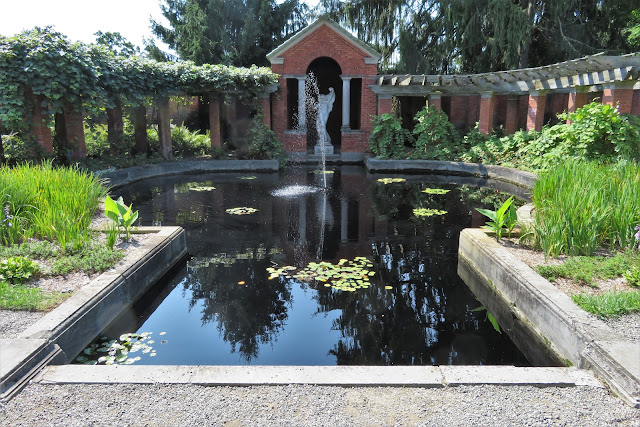We left Rhinebeck, New York, in late
August 2018, but not before taking a guided tour of the lavish Vanderbilt
Mansion. Built in 1896-1899, during the Gilded Age (the period following the Civil
War to the turn of the century), this was a time of unparalleled growth in
industry, technology, and immigration. The Vanderbilts, who made their fortune
in the railroad, were among the captains of industry who amassed unimaginable
wealth, while the average annual income in the US was under $400. William and
Louise Vanderbilt bought the mansion, referred to as Hyde Park, to use as their
spring and fall country estate. They hired top architects to design the mansion
in the neoclassical style with all the latest innovations: electricity, central
heating, and indoor plumbing. Furnishings and construction costs totaled around
$2,250,000.
Louise loved to entertain, throwing
lavish weekend parties with horseback riding, golf, tennis, and swimming
followed by formal dinners. Guests would mingle in the home’s foyer before
sitting down for a seven-course dinner, a different wine being served with each
course. The men and women would then split off to two separate parlors; women
to discuss fashion, men to discuss business. They would then convene in the
drawing room before heading off to bed at midnight.
The most important guests, determined by
name and wealth, would sleep on the second floor where Fredrick and Louise also
slept. Desiring to live like royalty, Louise’s room mirrors Marie Antoinette’s
chambers at the Palace of Versailles in France. Of the 19 rooms on the third
floor, 11 belonged to servants. The others slept on the basement level, where
laundry and cooking were done. Each morning, floors were cleaned, silverware, polished,
porches swept and 50 to 60 bouquets of fresh flowers were arranged throughout
the home.
William
and Louise did not have any children, and in 1938 the mansion was left to a niece,
Margaret Louise Van Alen, who did not want it, the 30 outbuildings on the property,
or the almost 70 acres of land. Following 50 years of opulence and encompassing
the rise and fall of a family empire, Vanderbilt Mansion was nothing more than
a relic of the Gilded Age of America. Van Alen tried to sell it for $350,000,
then for $250,000, but no one bought it. This was during the end of the
depression, and people couldn’t afford it, or didn’t want to live so lavishly. Upon
the suggestion of her neighbor, Franklin D. Roosevelt, Van Alen donated the
property to the National Park Service.
It was
mind boggling imagining this family’s wealth, how they lived, and how their
fortune was won and lost. Our tour guide captivatingly portrayed this part of
history, this family’s history, in vivid terms and great detail, as we strolled
the grounds and toured the house. Here are some pictures of our visit.


































No comments:
Post a Comment